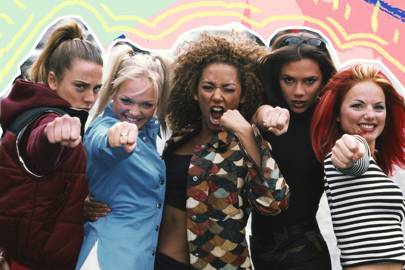[ad_1]

To mark GLAMOUR magazine's 20th anniversary, which just so happens to fall on International Women's Day, Yuan Ren looks back at exactly what has changed for women over the past 20 years...
The 90s had seen the Spice Girls storm the world with Girl Power and Britney Spears defy school regulations with an impromptu dance-off. In real life, UK law finally deemed rape within a marriage illegal after years of female campaigning. By the 2000s, Destiny’s Child told us what an Independent Woman looked like, with help from Charlie’s Angels.
Yet, it was also the age of sexual predators like Harvey Weinstein, and when the US president could destroy a young Monica Lewinsky’s life by wishing her away. Men called the shots, and the law was firmly on their side.
Pop culture painted a very glossy picture of the 21st Century woman. Anything boys can do, we can do better: in the UK, girls were outperforming boys in primary school, GCSEs and A-levels, and creating an “attainment gender gap”. It didn’t cause too much concern, given that men still earned 27% more than women. It was only until The Equality Act 2010, known as “the most important law on sexual harassment in the workplace”, that legislation defined what constituted sexual harassment, allowing more women to fight their cases in court.
The dawn of the Millennium was still when models and celebrities were cover girls and where only perfection – mostly white, slender and delicate – was celebrated. There were some signs of change in the “Bootylicious” Beyonce and Jennifer Lopez, but even so, many women rightly saw their sculpted bodies as wildly unattainable.
In this space, Glamour magazine launched in April 2001, adding a dollop of glamour into ordinary women’s lives. As a teenage reader, I, like many others, tried to emulate Covergirl Reese Witherspoon in 2005.
GLAMOUR Women of the Year Sports Gamechanger: Naomi Osaka on activism, racism and speaking out – ‘I want to be a voice for change’Women’s magazines have since broadened their content, uniting readers through global interests and experiences. Hijab-wearing women, as well as headlines like “She fled the Taliban and became a supermodel” (Glamour June 2016), contrast nicely with “Party Outfit SOS”. In no small part to Black Lives Matter, women of colour are being seen as never before. Glamour’s January Self Love issue featured ten different cover women and celebrated their stretch marks, body hair and achievements.
Women have also embraced more athletic and healthier body types, accompanied by a surge in mass and regular sports participation, spearheaded by recent British successes such as Paula Radcliff (marathon world record holder 2003), Olympic gold medallists Jessica Ennis-Hill (2012) and Kelly Holmes (2004). It has literally changed the British landscape: the number of women hitting the roads, parks and gyms for exercise today would have shocked people 20-years-ago.
The #Metoo movement of 2017 set a precedent for sexual harassment in the workplace and dispelled much of its shame around sexual harassment. In a 2020 survey by UK Trade Union Congress (TUC), 68% of people surveyed said the #MeToo movement had prompted more openness about sexual harassment.
Yet prosecutions for sexual harassment cases remain low, and discrimination against abuse victims is still evident. A study in the journal SAGE showed that women who self-reported sexual harassment were less likely to be recommended for promotion by work colleague than where cases were reported by a co-worker, showing the reality for women who speak out.
Everything you need to know about GLAMOUR Women of The Year Awards 2021: The GamechangersAnother major bottleneck for gender equality in the 21st century remains, unsurprisingly, childbearing. The gender pay gap drastically widens when a woman has her first baby, and such “penalties” are irreversible even after mothers return to work, which is why getting shared parenting right is so critical.
But the UK’s Shared Parental Leave Scheme introduced in 2015 has seen a low uptake, as low as 2%. Not only is it unavailable to self-employedworkers – which make up 15% of the workforce – paternity pay is often lower than enhanced maternity pay, depending on the generosity of your firm. Uptake also requires the mother to cut short her maternity leave, another barrier to its adoption.
It’s hoped that the 2017 gender pay gap reporting regulation, which requires all companies with 250 staff to submit the average gender pay gap, will incentivise employers to do more to even the playing field.
Gender pay gaps are seeded as early as school, with girls’ uptake in STEM subjects low from A-level. The imbalance later becomes amplified, given STEM students earn on average 30% more on graduation.
'I was corrected on the pronunciation of my own name': On International Women's Day, GLAMOUR readers reveal the most sexist things people have said to them (and they'll shock you)And while women are owning their bodies and leading more active lifestyles, we’re facing new barriers: a recent survey found that 46% of female runners in the UK have been harassed in some form while running.
Crucially, ethnic minority women are getting left behind, and no conversation about gender equality should overlook this. Today, the gender pay gap still stands at 15% and even higher for certain groups, such as 23.3% for Indians. From the invisibility of Asian women in sports to ethnic women being more likely to suffer domestic violence, racism and home-schooling pressures – given larger family sizes – will need greater coverage in the coming decade.
Behind every success mentioned at the start of this article is a man, from the male manager of Spice Girls to Britney Spears’ father and the Charlie in Charlie’s Angels. We must continue championing women from all backgrounds, but none of it is possible without campaigning for further legislative changes. Let's hope the next twenty years will see women truly driving their own successes.
Source link
[ad_2]
source https://earn8online.com/index.php/220636/how-much-has-changed-for-women-in-20-years/
No comments:
Post a Comment